Analyze the Impact of Stakeholders on Corporate Decision Making
VerifiedAdded on 2019/12/03
|16
|5852
|319
Report
AI Summary
Here is a short summary of the assignment content in a paragraph: The provided content discusses various topics related to business, economics, and management. It touches upon fiscal policy and its limitations, stakeholder governance, environmental regulations, and their unintended consequences. Additionally, it explores the impact of business environment changes on global manufacturing outsourcing and the role of stakeholders as CSR motivators.
Contribute Materials
Your contribution can guide someone’s learning journey. Share your
documents today.
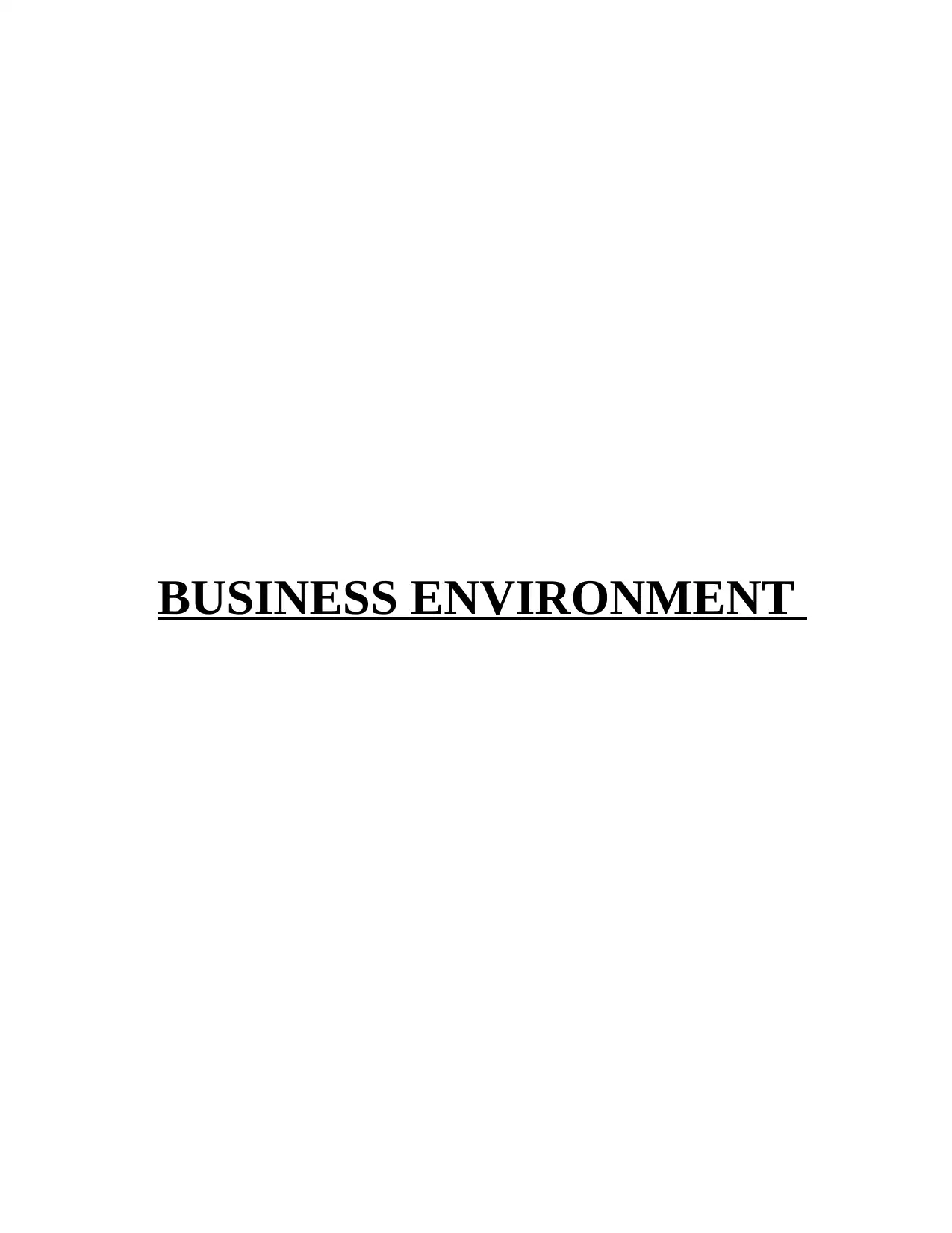
BUSINESS ENVIRONMENT
Secure Best Marks with AI Grader
Need help grading? Try our AI Grader for instant feedback on your assignments.
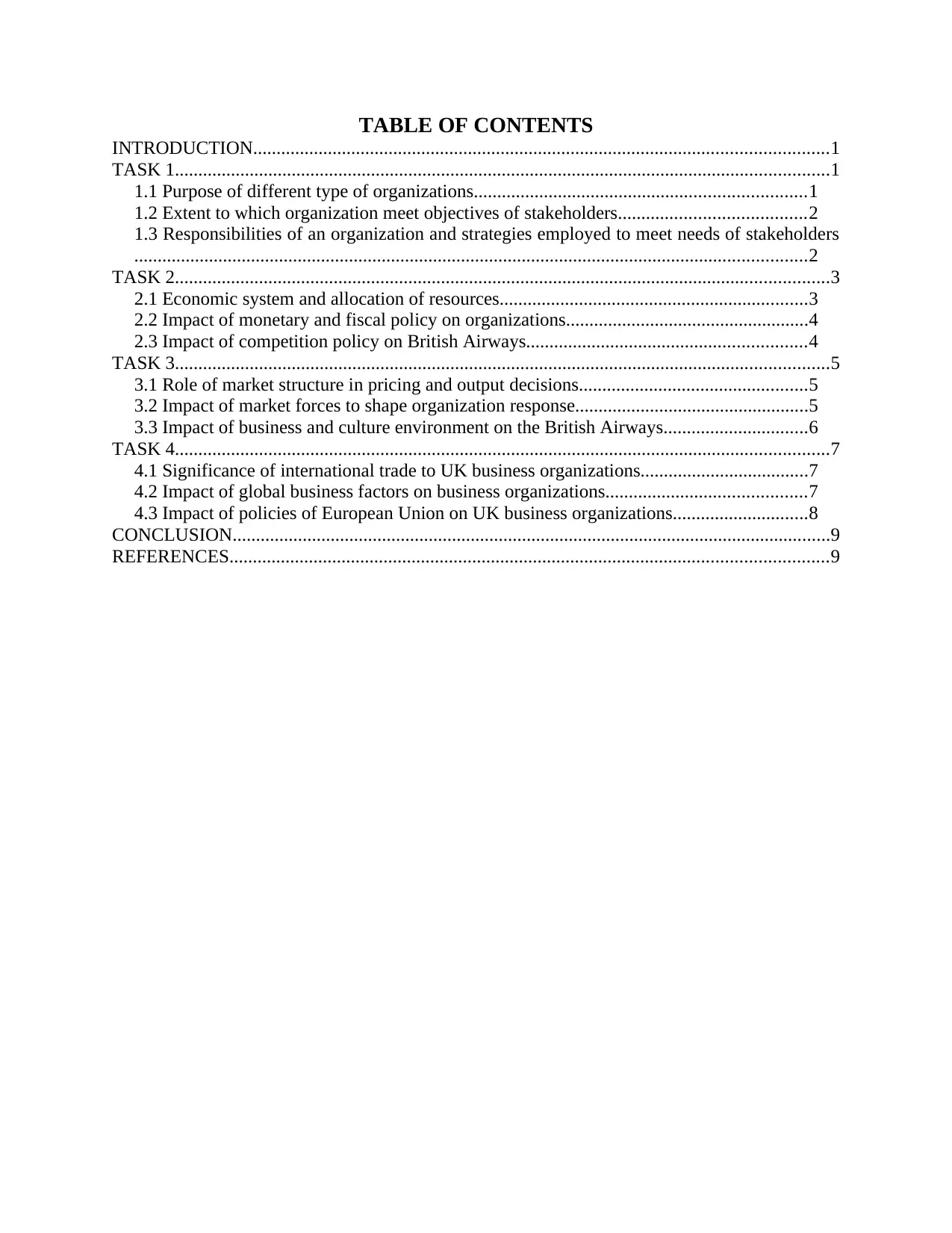
TABLE OF CONTENTS
INTRODUCTION...........................................................................................................................1
TASK 1............................................................................................................................................1
1.1 Purpose of different type of organizations.......................................................................1
1.2 Extent to which organization meet objectives of stakeholders........................................2
1.3 Responsibilities of an organization and strategies employed to meet needs of stakeholders
................................................................................................................................................2
TASK 2............................................................................................................................................3
2.1 Economic system and allocation of resources..................................................................3
2.2 Impact of monetary and fiscal policy on organizations....................................................4
2.3 Impact of competition policy on British Airways............................................................4
TASK 3............................................................................................................................................5
3.1 Role of market structure in pricing and output decisions.................................................5
3.2 Impact of market forces to shape organization response..................................................5
3.3 Impact of business and culture environment on the British Airways...............................6
TASK 4............................................................................................................................................7
4.1 Significance of international trade to UK business organizations....................................7
4.2 Impact of global business factors on business organizations...........................................7
4.3 Impact of policies of European Union on UK business organizations.............................8
CONCLUSION................................................................................................................................9
REFERENCES................................................................................................................................9
INTRODUCTION...........................................................................................................................1
TASK 1............................................................................................................................................1
1.1 Purpose of different type of organizations.......................................................................1
1.2 Extent to which organization meet objectives of stakeholders........................................2
1.3 Responsibilities of an organization and strategies employed to meet needs of stakeholders
................................................................................................................................................2
TASK 2............................................................................................................................................3
2.1 Economic system and allocation of resources..................................................................3
2.2 Impact of monetary and fiscal policy on organizations....................................................4
2.3 Impact of competition policy on British Airways............................................................4
TASK 3............................................................................................................................................5
3.1 Role of market structure in pricing and output decisions.................................................5
3.2 Impact of market forces to shape organization response..................................................5
3.3 Impact of business and culture environment on the British Airways...............................6
TASK 4............................................................................................................................................7
4.1 Significance of international trade to UK business organizations....................................7
4.2 Impact of global business factors on business organizations...........................................7
4.3 Impact of policies of European Union on UK business organizations.............................8
CONCLUSION................................................................................................................................9
REFERENCES................................................................................................................................9

INTRODUCTION
British Airways in terms of fleet size is the second largest airline in the UK. This report is
prepared on business environment in order to help readers in understanding the impact of change
in business environment. In this report, stakeholders and their importance from company point of
view is discussed in detail. Along with this, strategies are also mentioned in the report that can be
adopted in order to maintain good relations with the stakeholders. Further, fiscal and monetary
policy and their impact on organization are also discussed in detail. At the end of report,
significance of international trade on the UK aviation industry in respect to British Airways is
also discussed in detail.
TASK 1
1.1 Purpose of different type of organizations
There are three kinds of organizations like public, private and nonprofit organizations.
Purpose of these organizations is given below. Sole trader- These are mainly small sized business that have limited resources. Their
main aim to increase their profitability. Due to this reason their main purpose is to control
cost as much as possible. Partnership- In this mode of business multiple people as an owner of business operate a
firm. Their main purpose is to increase profitability of the firm by taking mutual
agreeable decision. Public organizations- The main purpose of such kind of organizations is to create
employment opportunities. Welfare of existing labor force is another important objective
of these public sector organizations. Due to this reason these firms mostly run in loss or
they are not able to generate sufficient amount of profits. Private organization- British Airways is a private firm and profit maximization is its
primary objective which is divided into various sub objectives (Diedrich, 2014). The
organization is able to achieve its long-term objectives through achievement of short-
term targets or benchmarks. These firms strictly follow the business policy. However in
order to earn more amount of profit, the employees’ welfare is ignored sometimes.
1
British Airways in terms of fleet size is the second largest airline in the UK. This report is
prepared on business environment in order to help readers in understanding the impact of change
in business environment. In this report, stakeholders and their importance from company point of
view is discussed in detail. Along with this, strategies are also mentioned in the report that can be
adopted in order to maintain good relations with the stakeholders. Further, fiscal and monetary
policy and their impact on organization are also discussed in detail. At the end of report,
significance of international trade on the UK aviation industry in respect to British Airways is
also discussed in detail.
TASK 1
1.1 Purpose of different type of organizations
There are three kinds of organizations like public, private and nonprofit organizations.
Purpose of these organizations is given below. Sole trader- These are mainly small sized business that have limited resources. Their
main aim to increase their profitability. Due to this reason their main purpose is to control
cost as much as possible. Partnership- In this mode of business multiple people as an owner of business operate a
firm. Their main purpose is to increase profitability of the firm by taking mutual
agreeable decision. Public organizations- The main purpose of such kind of organizations is to create
employment opportunities. Welfare of existing labor force is another important objective
of these public sector organizations. Due to this reason these firms mostly run in loss or
they are not able to generate sufficient amount of profits. Private organization- British Airways is a private firm and profit maximization is its
primary objective which is divided into various sub objectives (Diedrich, 2014). The
organization is able to achieve its long-term objectives through achievement of short-
term targets or benchmarks. These firms strictly follow the business policy. However in
order to earn more amount of profit, the employees’ welfare is ignored sometimes.
1
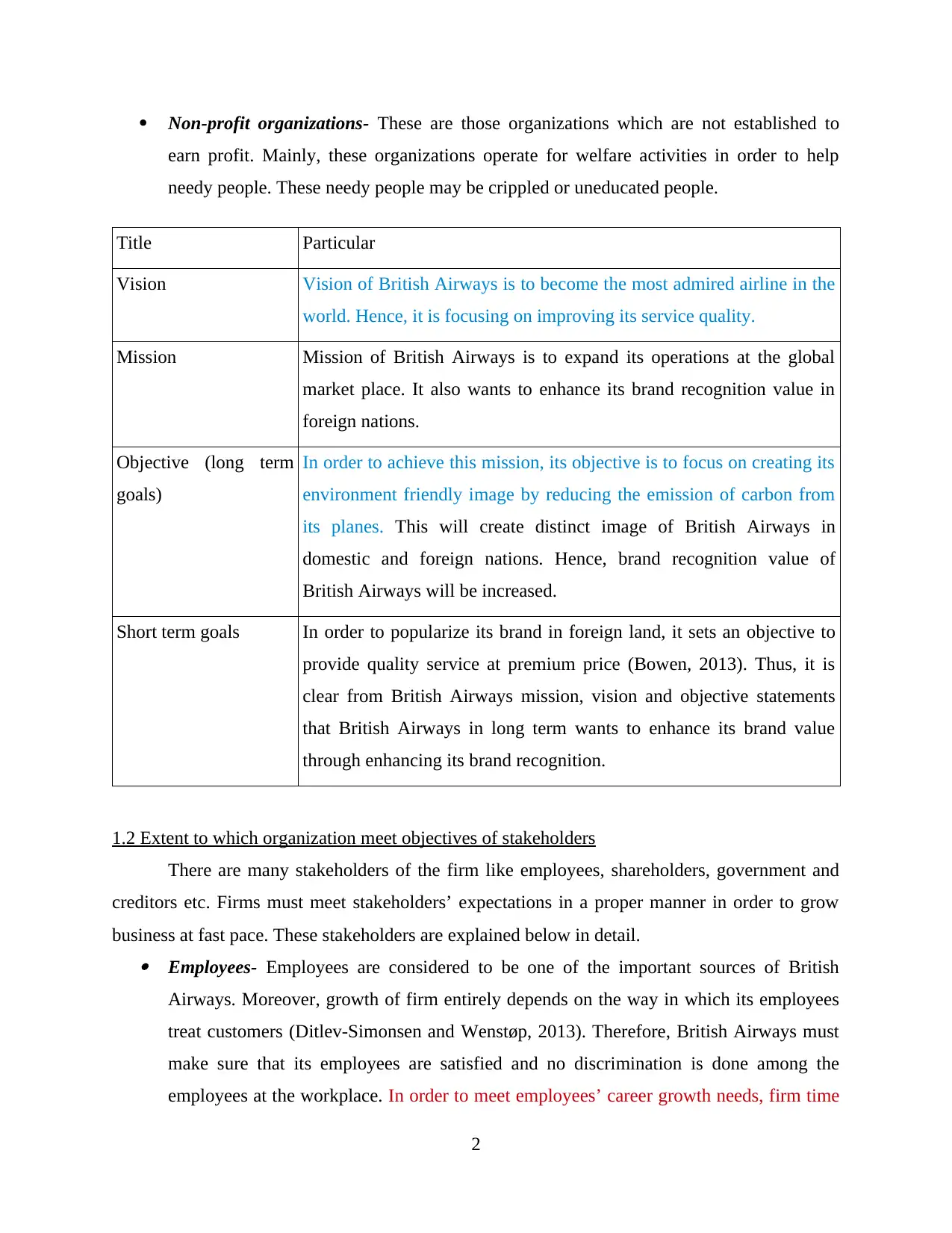
Non-profit organizations- These are those organizations which are not established to
earn profit. Mainly, these organizations operate for welfare activities in order to help
needy people. These needy people may be crippled or uneducated people.
Title Particular
Vision Vision of British Airways is to become the most admired airline in the
world. Hence, it is focusing on improving its service quality.
Mission Mission of British Airways is to expand its operations at the global
market place. It also wants to enhance its brand recognition value in
foreign nations.
Objective (long term
goals)
In order to achieve this mission, its objective is to focus on creating its
environment friendly image by reducing the emission of carbon from
its planes. This will create distinct image of British Airways in
domestic and foreign nations. Hence, brand recognition value of
British Airways will be increased.
Short term goals In order to popularize its brand in foreign land, it sets an objective to
provide quality service at premium price (Bowen, 2013). Thus, it is
clear from British Airways mission, vision and objective statements
that British Airways in long term wants to enhance its brand value
through enhancing its brand recognition.
1.2 Extent to which organization meet objectives of stakeholders
There are many stakeholders of the firm like employees, shareholders, government and
creditors etc. Firms must meet stakeholders’ expectations in a proper manner in order to grow
business at fast pace. These stakeholders are explained below in detail. Employees- Employees are considered to be one of the important sources of British
Airways. Moreover, growth of firm entirely depends on the way in which its employees
treat customers (Ditlev-Simonsen and Wenstøp, 2013). Therefore, British Airways must
make sure that its employees are satisfied and no discrimination is done among the
employees at the workplace. In order to meet employees’ career growth needs, firm time
2
earn profit. Mainly, these organizations operate for welfare activities in order to help
needy people. These needy people may be crippled or uneducated people.
Title Particular
Vision Vision of British Airways is to become the most admired airline in the
world. Hence, it is focusing on improving its service quality.
Mission Mission of British Airways is to expand its operations at the global
market place. It also wants to enhance its brand recognition value in
foreign nations.
Objective (long term
goals)
In order to achieve this mission, its objective is to focus on creating its
environment friendly image by reducing the emission of carbon from
its planes. This will create distinct image of British Airways in
domestic and foreign nations. Hence, brand recognition value of
British Airways will be increased.
Short term goals In order to popularize its brand in foreign land, it sets an objective to
provide quality service at premium price (Bowen, 2013). Thus, it is
clear from British Airways mission, vision and objective statements
that British Airways in long term wants to enhance its brand value
through enhancing its brand recognition.
1.2 Extent to which organization meet objectives of stakeholders
There are many stakeholders of the firm like employees, shareholders, government and
creditors etc. Firms must meet stakeholders’ expectations in a proper manner in order to grow
business at fast pace. These stakeholders are explained below in detail. Employees- Employees are considered to be one of the important sources of British
Airways. Moreover, growth of firm entirely depends on the way in which its employees
treat customers (Ditlev-Simonsen and Wenstøp, 2013). Therefore, British Airways must
make sure that its employees are satisfied and no discrimination is done among the
employees at the workplace. In order to meet employees’ career growth needs, firm time
2
Secure Best Marks with AI Grader
Need help grading? Try our AI Grader for instant feedback on your assignments.
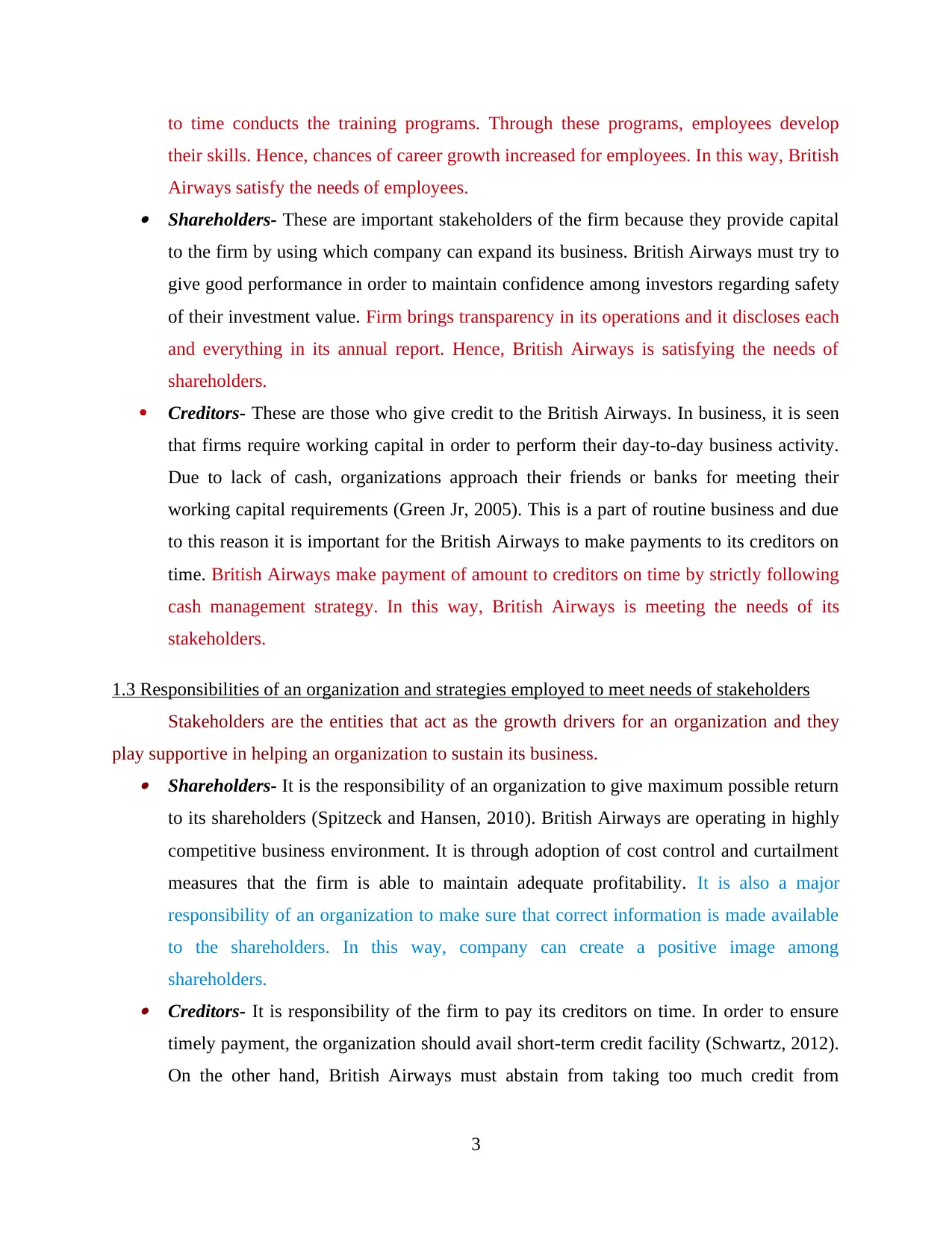
to time conducts the training programs. Through these programs, employees develop
their skills. Hence, chances of career growth increased for employees. In this way, British
Airways satisfy the needs of employees. Shareholders- These are important stakeholders of the firm because they provide capital
to the firm by using which company can expand its business. British Airways must try to
give good performance in order to maintain confidence among investors regarding safety
of their investment value. Firm brings transparency in its operations and it discloses each
and everything in its annual report. Hence, British Airways is satisfying the needs of
shareholders.
Creditors- These are those who give credit to the British Airways. In business, it is seen
that firms require working capital in order to perform their day-to-day business activity.
Due to lack of cash, organizations approach their friends or banks for meeting their
working capital requirements (Green Jr, 2005). This is a part of routine business and due
to this reason it is important for the British Airways to make payments to its creditors on
time. British Airways make payment of amount to creditors on time by strictly following
cash management strategy. In this way, British Airways is meeting the needs of its
stakeholders.
1.3 Responsibilities of an organization and strategies employed to meet needs of stakeholders
Stakeholders are the entities that act as the growth drivers for an organization and they
play supportive in helping an organization to sustain its business. Shareholders- It is the responsibility of an organization to give maximum possible return
to its shareholders (Spitzeck and Hansen, 2010). British Airways are operating in highly
competitive business environment. It is through adoption of cost control and curtailment
measures that the firm is able to maintain adequate profitability. It is also a major
responsibility of an organization to make sure that correct information is made available
to the shareholders. In this way, company can create a positive image among
shareholders. Creditors- It is responsibility of the firm to pay its creditors on time. In order to ensure
timely payment, the organization should avail short-term credit facility (Schwartz, 2012).
On the other hand, British Airways must abstain from taking too much credit from
3
their skills. Hence, chances of career growth increased for employees. In this way, British
Airways satisfy the needs of employees. Shareholders- These are important stakeholders of the firm because they provide capital
to the firm by using which company can expand its business. British Airways must try to
give good performance in order to maintain confidence among investors regarding safety
of their investment value. Firm brings transparency in its operations and it discloses each
and everything in its annual report. Hence, British Airways is satisfying the needs of
shareholders.
Creditors- These are those who give credit to the British Airways. In business, it is seen
that firms require working capital in order to perform their day-to-day business activity.
Due to lack of cash, organizations approach their friends or banks for meeting their
working capital requirements (Green Jr, 2005). This is a part of routine business and due
to this reason it is important for the British Airways to make payments to its creditors on
time. British Airways make payment of amount to creditors on time by strictly following
cash management strategy. In this way, British Airways is meeting the needs of its
stakeholders.
1.3 Responsibilities of an organization and strategies employed to meet needs of stakeholders
Stakeholders are the entities that act as the growth drivers for an organization and they
play supportive in helping an organization to sustain its business. Shareholders- It is the responsibility of an organization to give maximum possible return
to its shareholders (Spitzeck and Hansen, 2010). British Airways are operating in highly
competitive business environment. It is through adoption of cost control and curtailment
measures that the firm is able to maintain adequate profitability. It is also a major
responsibility of an organization to make sure that correct information is made available
to the shareholders. In this way, company can create a positive image among
shareholders. Creditors- It is responsibility of the firm to pay its creditors on time. In order to ensure
timely payment, the organization should avail short-term credit facility (Schwartz, 2012).
On the other hand, British Airways must abstain from taking too much credit from
3
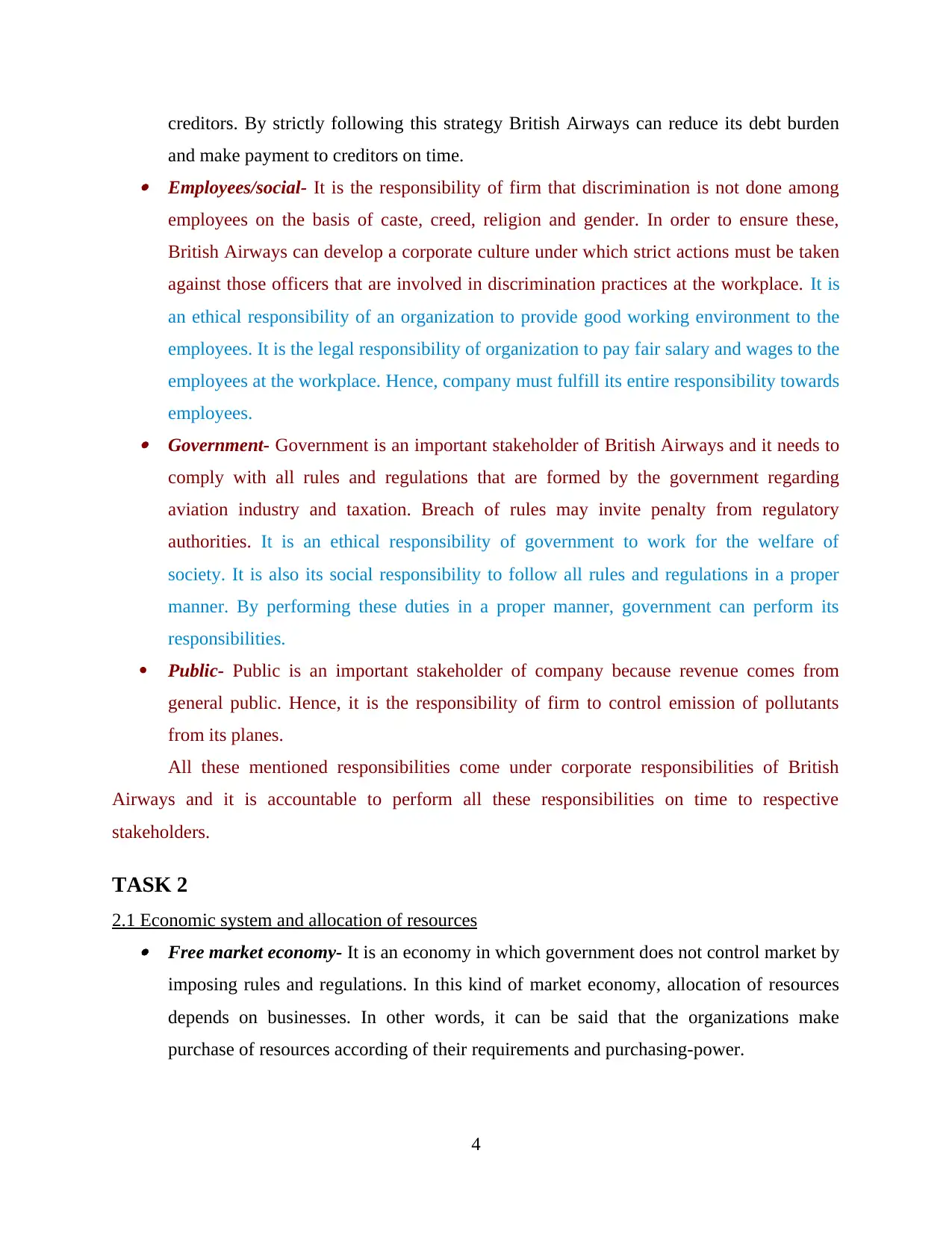
creditors. By strictly following this strategy British Airways can reduce its debt burden
and make payment to creditors on time. Employees/social- It is the responsibility of firm that discrimination is not done among
employees on the basis of caste, creed, religion and gender. In order to ensure these,
British Airways can develop a corporate culture under which strict actions must be taken
against those officers that are involved in discrimination practices at the workplace. It is
an ethical responsibility of an organization to provide good working environment to the
employees. It is the legal responsibility of organization to pay fair salary and wages to the
employees at the workplace. Hence, company must fulfill its entire responsibility towards
employees. Government- Government is an important stakeholder of British Airways and it needs to
comply with all rules and regulations that are formed by the government regarding
aviation industry and taxation. Breach of rules may invite penalty from regulatory
authorities. It is an ethical responsibility of government to work for the welfare of
society. It is also its social responsibility to follow all rules and regulations in a proper
manner. By performing these duties in a proper manner, government can perform its
responsibilities.
Public- Public is an important stakeholder of company because revenue comes from
general public. Hence, it is the responsibility of firm to control emission of pollutants
from its planes.
All these mentioned responsibilities come under corporate responsibilities of British
Airways and it is accountable to perform all these responsibilities on time to respective
stakeholders.
TASK 2
2.1 Economic system and allocation of resources Free market economy- It is an economy in which government does not control market by
imposing rules and regulations. In this kind of market economy, allocation of resources
depends on businesses. In other words, it can be said that the organizations make
purchase of resources according of their requirements and purchasing-power.
4
and make payment to creditors on time. Employees/social- It is the responsibility of firm that discrimination is not done among
employees on the basis of caste, creed, religion and gender. In order to ensure these,
British Airways can develop a corporate culture under which strict actions must be taken
against those officers that are involved in discrimination practices at the workplace. It is
an ethical responsibility of an organization to provide good working environment to the
employees. It is the legal responsibility of organization to pay fair salary and wages to the
employees at the workplace. Hence, company must fulfill its entire responsibility towards
employees. Government- Government is an important stakeholder of British Airways and it needs to
comply with all rules and regulations that are formed by the government regarding
aviation industry and taxation. Breach of rules may invite penalty from regulatory
authorities. It is an ethical responsibility of government to work for the welfare of
society. It is also its social responsibility to follow all rules and regulations in a proper
manner. By performing these duties in a proper manner, government can perform its
responsibilities.
Public- Public is an important stakeholder of company because revenue comes from
general public. Hence, it is the responsibility of firm to control emission of pollutants
from its planes.
All these mentioned responsibilities come under corporate responsibilities of British
Airways and it is accountable to perform all these responsibilities on time to respective
stakeholders.
TASK 2
2.1 Economic system and allocation of resources Free market economy- It is an economy in which government does not control market by
imposing rules and regulations. In this kind of market economy, allocation of resources
depends on businesses. In other words, it can be said that the organizations make
purchase of resources according of their requirements and purchasing-power.
4
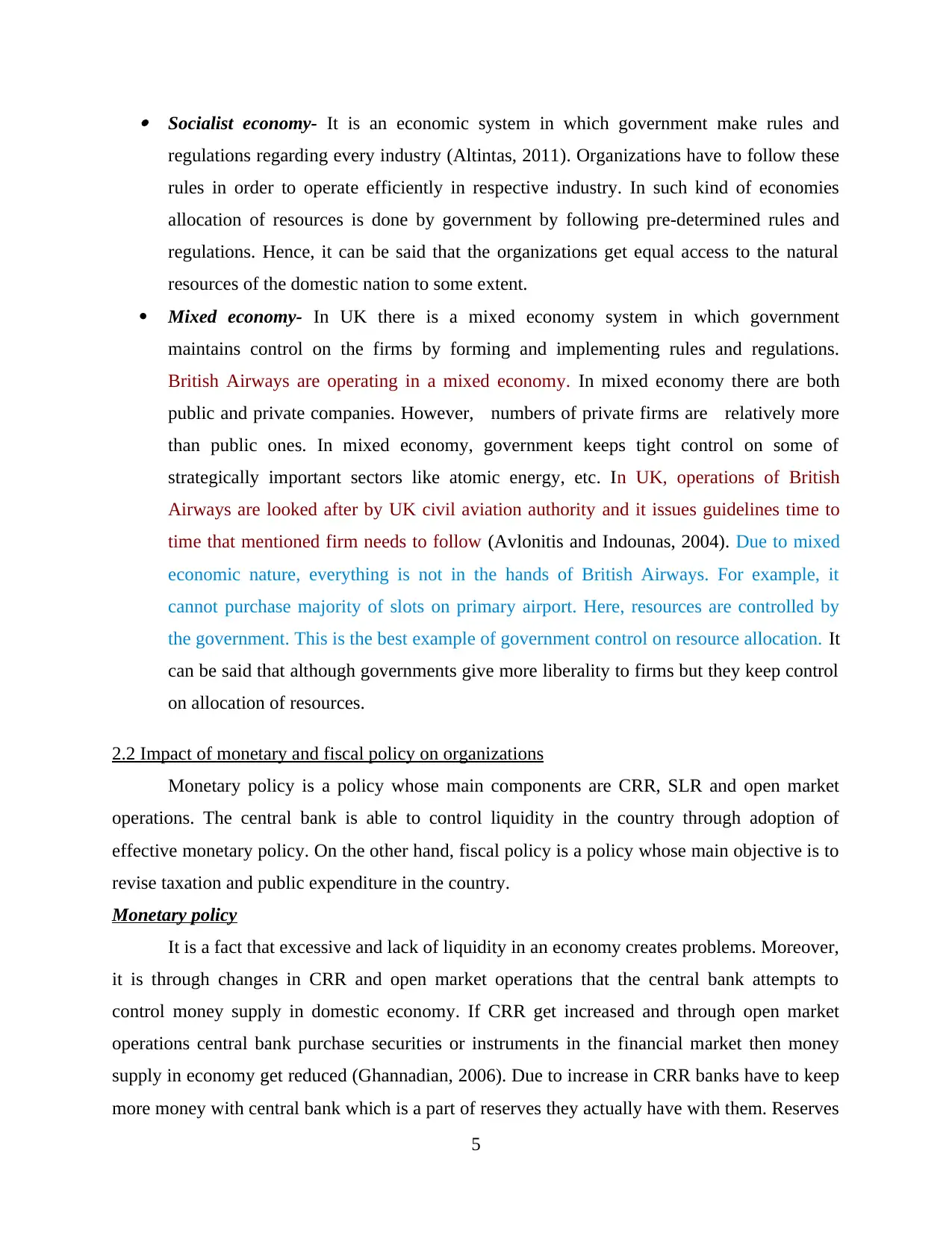
Socialist economy- It is an economic system in which government make rules and
regulations regarding every industry (Altintas, 2011). Organizations have to follow these
rules in order to operate efficiently in respective industry. In such kind of economies
allocation of resources is done by government by following pre-determined rules and
regulations. Hence, it can be said that the organizations get equal access to the natural
resources of the domestic nation to some extent.
Mixed economy- In UK there is a mixed economy system in which government
maintains control on the firms by forming and implementing rules and regulations.
British Airways are operating in a mixed economy. In mixed economy there are both
public and private companies. However, numbers of private firms are relatively more
than public ones. In mixed economy, government keeps tight control on some of
strategically important sectors like atomic energy, etc. In UK, operations of British
Airways are looked after by UK civil aviation authority and it issues guidelines time to
time that mentioned firm needs to follow (Avlonitis and Indounas, 2004). Due to mixed
economic nature, everything is not in the hands of British Airways. For example, it
cannot purchase majority of slots on primary airport. Here, resources are controlled by
the government. This is the best example of government control on resource allocation. It
can be said that although governments give more liberality to firms but they keep control
on allocation of resources.
2.2 Impact of monetary and fiscal policy on organizations
Monetary policy is a policy whose main components are CRR, SLR and open market
operations. The central bank is able to control liquidity in the country through adoption of
effective monetary policy. On the other hand, fiscal policy is a policy whose main objective is to
revise taxation and public expenditure in the country.
Monetary policy
It is a fact that excessive and lack of liquidity in an economy creates problems. Moreover,
it is through changes in CRR and open market operations that the central bank attempts to
control money supply in domestic economy. If CRR get increased and through open market
operations central bank purchase securities or instruments in the financial market then money
supply in economy get reduced (Ghannadian, 2006). Due to increase in CRR banks have to keep
more money with central bank which is a part of reserves they actually have with them. Reserves
5
regulations regarding every industry (Altintas, 2011). Organizations have to follow these
rules in order to operate efficiently in respective industry. In such kind of economies
allocation of resources is done by government by following pre-determined rules and
regulations. Hence, it can be said that the organizations get equal access to the natural
resources of the domestic nation to some extent.
Mixed economy- In UK there is a mixed economy system in which government
maintains control on the firms by forming and implementing rules and regulations.
British Airways are operating in a mixed economy. In mixed economy there are both
public and private companies. However, numbers of private firms are relatively more
than public ones. In mixed economy, government keeps tight control on some of
strategically important sectors like atomic energy, etc. In UK, operations of British
Airways are looked after by UK civil aviation authority and it issues guidelines time to
time that mentioned firm needs to follow (Avlonitis and Indounas, 2004). Due to mixed
economic nature, everything is not in the hands of British Airways. For example, it
cannot purchase majority of slots on primary airport. Here, resources are controlled by
the government. This is the best example of government control on resource allocation. It
can be said that although governments give more liberality to firms but they keep control
on allocation of resources.
2.2 Impact of monetary and fiscal policy on organizations
Monetary policy is a policy whose main components are CRR, SLR and open market
operations. The central bank is able to control liquidity in the country through adoption of
effective monetary policy. On the other hand, fiscal policy is a policy whose main objective is to
revise taxation and public expenditure in the country.
Monetary policy
It is a fact that excessive and lack of liquidity in an economy creates problems. Moreover,
it is through changes in CRR and open market operations that the central bank attempts to
control money supply in domestic economy. If CRR get increased and through open market
operations central bank purchase securities or instruments in the financial market then money
supply in economy get reduced (Ghannadian, 2006). Due to increase in CRR banks have to keep
more money with central bank which is a part of reserves they actually have with them. Reserves
5
Paraphrase This Document
Need a fresh take? Get an instant paraphrase of this document with our AI Paraphraser
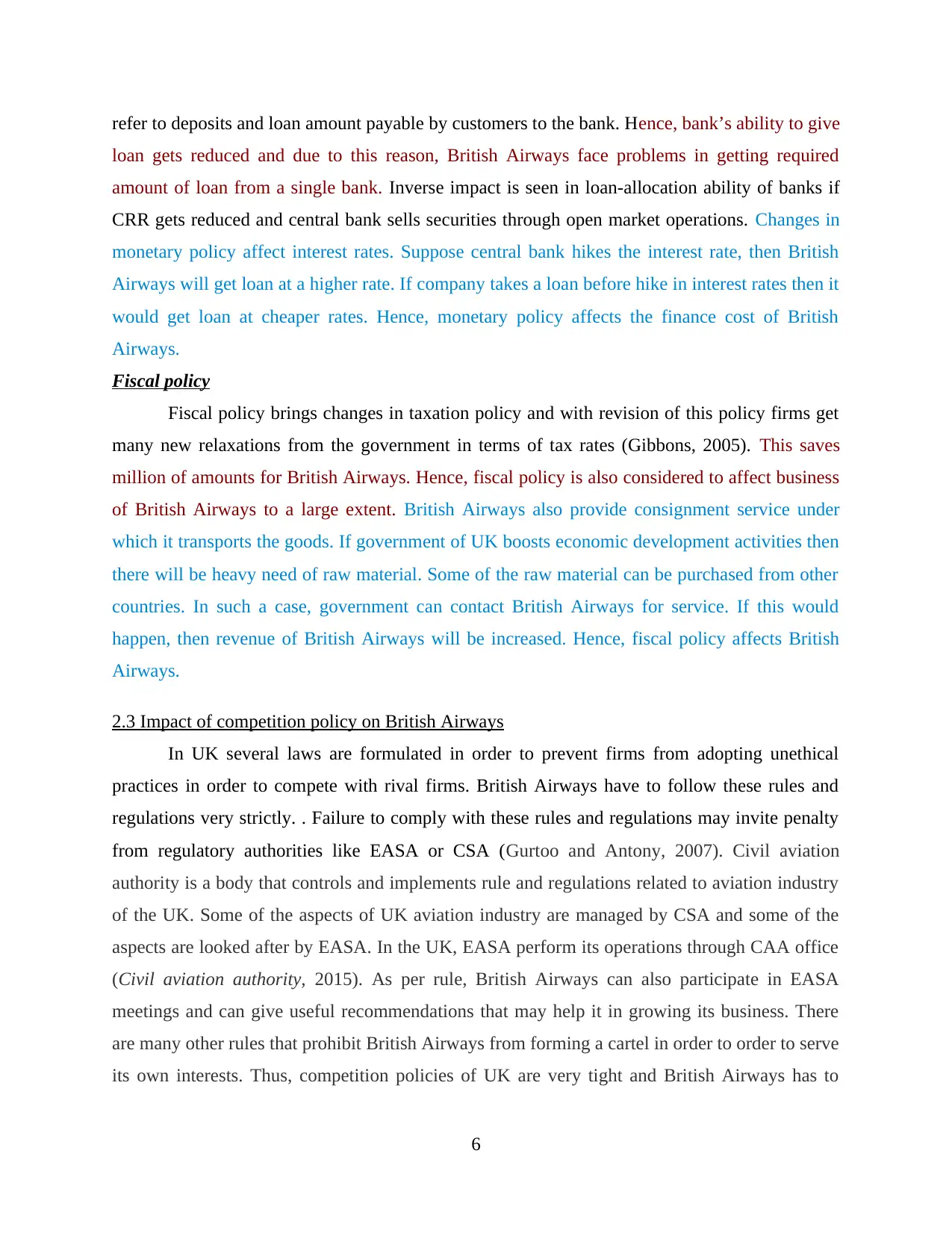
refer to deposits and loan amount payable by customers to the bank. Hence, bank’s ability to give
loan gets reduced and due to this reason, British Airways face problems in getting required
amount of loan from a single bank. Inverse impact is seen in loan-allocation ability of banks if
CRR gets reduced and central bank sells securities through open market operations. Changes in
monetary policy affect interest rates. Suppose central bank hikes the interest rate, then British
Airways will get loan at a higher rate. If company takes a loan before hike in interest rates then it
would get loan at cheaper rates. Hence, monetary policy affects the finance cost of British
Airways.
Fiscal policy
Fiscal policy brings changes in taxation policy and with revision of this policy firms get
many new relaxations from the government in terms of tax rates (Gibbons, 2005). This saves
million of amounts for British Airways. Hence, fiscal policy is also considered to affect business
of British Airways to a large extent. British Airways also provide consignment service under
which it transports the goods. If government of UK boosts economic development activities then
there will be heavy need of raw material. Some of the raw material can be purchased from other
countries. In such a case, government can contact British Airways for service. If this would
happen, then revenue of British Airways will be increased. Hence, fiscal policy affects British
Airways.
2.3 Impact of competition policy on British Airways
In UK several laws are formulated in order to prevent firms from adopting unethical
practices in order to compete with rival firms. British Airways have to follow these rules and
regulations very strictly. . Failure to comply with these rules and regulations may invite penalty
from regulatory authorities like EASA or CSA (Gurtoo and Antony, 2007). Civil aviation
authority is a body that controls and implements rule and regulations related to aviation industry
of the UK. Some of the aspects of UK aviation industry are managed by CSA and some of the
aspects are looked after by EASA. In the UK, EASA perform its operations through CAA office
(Civil aviation authority, 2015). As per rule, British Airways can also participate in EASA
meetings and can give useful recommendations that may help it in growing its business. There
are many other rules that prohibit British Airways from forming a cartel in order to order to serve
its own interests. Thus, competition policies of UK are very tight and British Airways has to
6
loan gets reduced and due to this reason, British Airways face problems in getting required
amount of loan from a single bank. Inverse impact is seen in loan-allocation ability of banks if
CRR gets reduced and central bank sells securities through open market operations. Changes in
monetary policy affect interest rates. Suppose central bank hikes the interest rate, then British
Airways will get loan at a higher rate. If company takes a loan before hike in interest rates then it
would get loan at cheaper rates. Hence, monetary policy affects the finance cost of British
Airways.
Fiscal policy
Fiscal policy brings changes in taxation policy and with revision of this policy firms get
many new relaxations from the government in terms of tax rates (Gibbons, 2005). This saves
million of amounts for British Airways. Hence, fiscal policy is also considered to affect business
of British Airways to a large extent. British Airways also provide consignment service under
which it transports the goods. If government of UK boosts economic development activities then
there will be heavy need of raw material. Some of the raw material can be purchased from other
countries. In such a case, government can contact British Airways for service. If this would
happen, then revenue of British Airways will be increased. Hence, fiscal policy affects British
Airways.
2.3 Impact of competition policy on British Airways
In UK several laws are formulated in order to prevent firms from adopting unethical
practices in order to compete with rival firms. British Airways have to follow these rules and
regulations very strictly. . Failure to comply with these rules and regulations may invite penalty
from regulatory authorities like EASA or CSA (Gurtoo and Antony, 2007). Civil aviation
authority is a body that controls and implements rule and regulations related to aviation industry
of the UK. Some of the aspects of UK aviation industry are managed by CSA and some of the
aspects are looked after by EASA. In the UK, EASA perform its operations through CAA office
(Civil aviation authority, 2015). As per rule, British Airways can also participate in EASA
meetings and can give useful recommendations that may help it in growing its business. There
are many other rules that prohibit British Airways from forming a cartel in order to order to serve
its own interests. Thus, competition policies of UK are very tight and British Airways has to
6
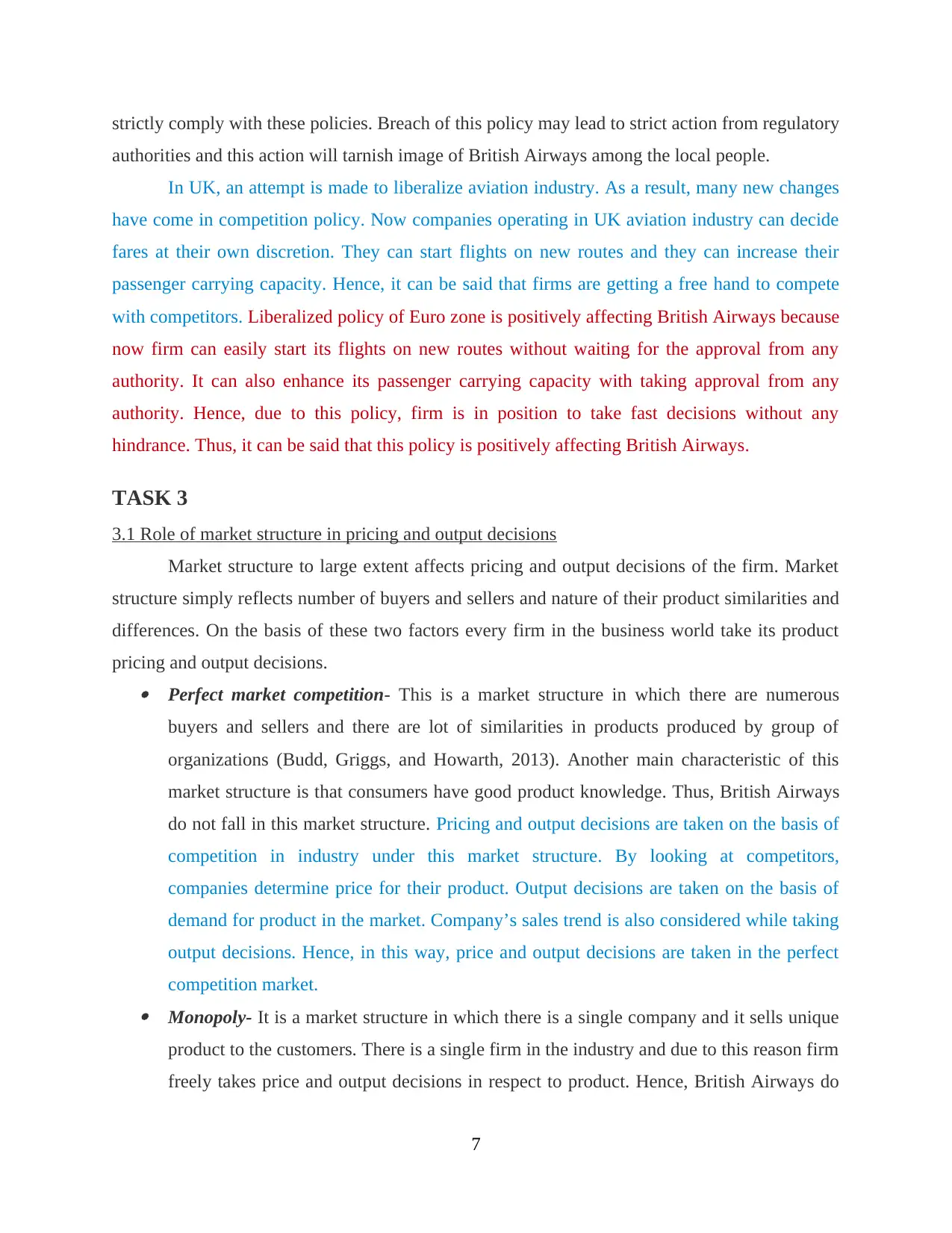
strictly comply with these policies. Breach of this policy may lead to strict action from regulatory
authorities and this action will tarnish image of British Airways among the local people.
In UK, an attempt is made to liberalize aviation industry. As a result, many new changes
have come in competition policy. Now companies operating in UK aviation industry can decide
fares at their own discretion. They can start flights on new routes and they can increase their
passenger carrying capacity. Hence, it can be said that firms are getting a free hand to compete
with competitors. Liberalized policy of Euro zone is positively affecting British Airways because
now firm can easily start its flights on new routes without waiting for the approval from any
authority. It can also enhance its passenger carrying capacity with taking approval from any
authority. Hence, due to this policy, firm is in position to take fast decisions without any
hindrance. Thus, it can be said that this policy is positively affecting British Airways.
TASK 3
3.1 Role of market structure in pricing and output decisions
Market structure to large extent affects pricing and output decisions of the firm. Market
structure simply reflects number of buyers and sellers and nature of their product similarities and
differences. On the basis of these two factors every firm in the business world take its product
pricing and output decisions. Perfect market competition- This is a market structure in which there are numerous
buyers and sellers and there are lot of similarities in products produced by group of
organizations (Budd, Griggs, and Howarth, 2013). Another main characteristic of this
market structure is that consumers have good product knowledge. Thus, British Airways
do not fall in this market structure. Pricing and output decisions are taken on the basis of
competition in industry under this market structure. By looking at competitors,
companies determine price for their product. Output decisions are taken on the basis of
demand for product in the market. Company’s sales trend is also considered while taking
output decisions. Hence, in this way, price and output decisions are taken in the perfect
competition market. Monopoly- It is a market structure in which there is a single company and it sells unique
product to the customers. There is a single firm in the industry and due to this reason firm
freely takes price and output decisions in respect to product. Hence, British Airways do
7
authorities and this action will tarnish image of British Airways among the local people.
In UK, an attempt is made to liberalize aviation industry. As a result, many new changes
have come in competition policy. Now companies operating in UK aviation industry can decide
fares at their own discretion. They can start flights on new routes and they can increase their
passenger carrying capacity. Hence, it can be said that firms are getting a free hand to compete
with competitors. Liberalized policy of Euro zone is positively affecting British Airways because
now firm can easily start its flights on new routes without waiting for the approval from any
authority. It can also enhance its passenger carrying capacity with taking approval from any
authority. Hence, due to this policy, firm is in position to take fast decisions without any
hindrance. Thus, it can be said that this policy is positively affecting British Airways.
TASK 3
3.1 Role of market structure in pricing and output decisions
Market structure to large extent affects pricing and output decisions of the firm. Market
structure simply reflects number of buyers and sellers and nature of their product similarities and
differences. On the basis of these two factors every firm in the business world take its product
pricing and output decisions. Perfect market competition- This is a market structure in which there are numerous
buyers and sellers and there are lot of similarities in products produced by group of
organizations (Budd, Griggs, and Howarth, 2013). Another main characteristic of this
market structure is that consumers have good product knowledge. Thus, British Airways
do not fall in this market structure. Pricing and output decisions are taken on the basis of
competition in industry under this market structure. By looking at competitors,
companies determine price for their product. Output decisions are taken on the basis of
demand for product in the market. Company’s sales trend is also considered while taking
output decisions. Hence, in this way, price and output decisions are taken in the perfect
competition market. Monopoly- It is a market structure in which there is a single company and it sells unique
product to the customers. There is a single firm in the industry and due to this reason firm
freely takes price and output decisions in respect to product. Hence, British Airways do
7
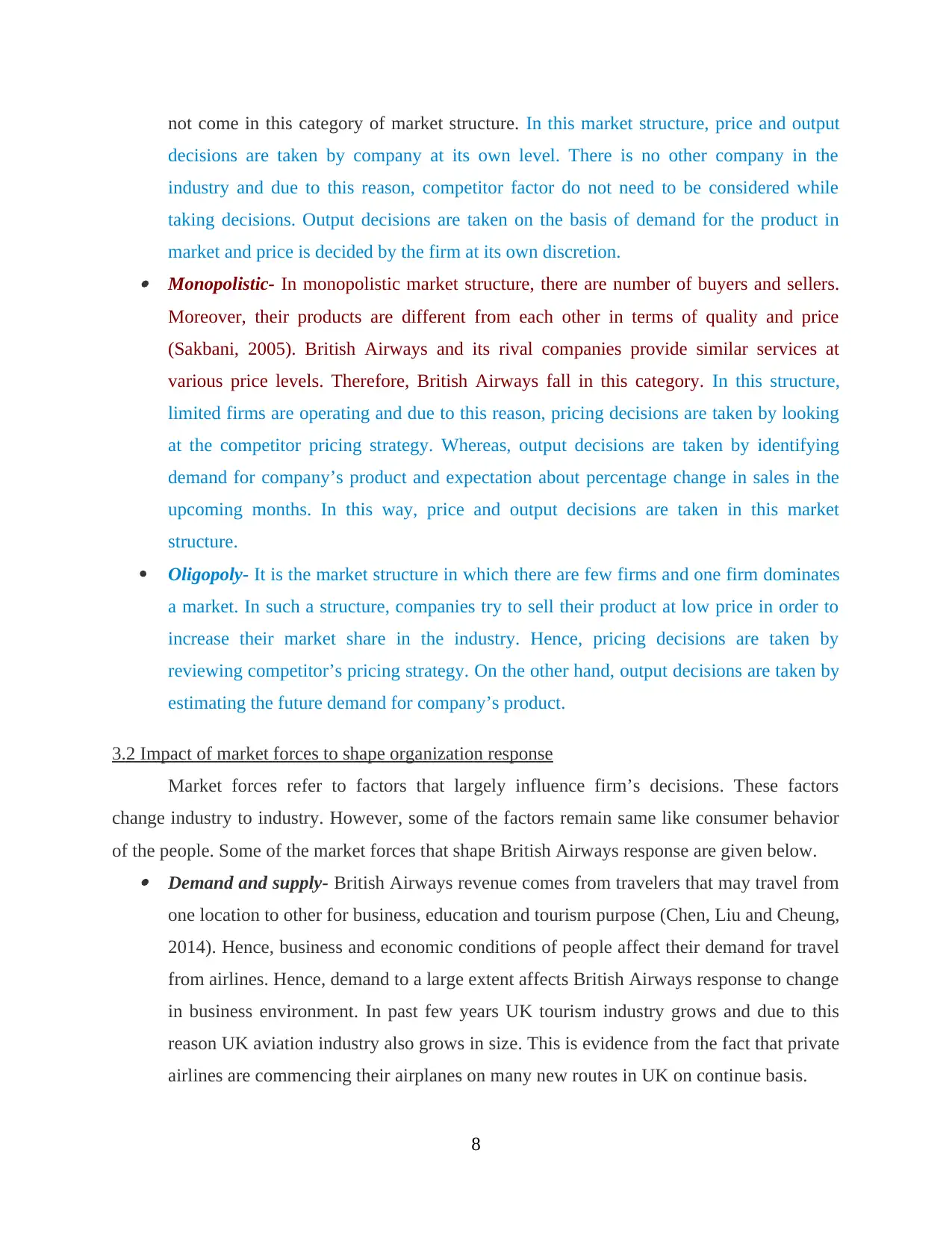
not come in this category of market structure. In this market structure, price and output
decisions are taken by company at its own level. There is no other company in the
industry and due to this reason, competitor factor do not need to be considered while
taking decisions. Output decisions are taken on the basis of demand for the product in
market and price is decided by the firm at its own discretion. Monopolistic- In monopolistic market structure, there are number of buyers and sellers.
Moreover, their products are different from each other in terms of quality and price
(Sakbani, 2005). British Airways and its rival companies provide similar services at
various price levels. Therefore, British Airways fall in this category. In this structure,
limited firms are operating and due to this reason, pricing decisions are taken by looking
at the competitor pricing strategy. Whereas, output decisions are taken by identifying
demand for company’s product and expectation about percentage change in sales in the
upcoming months. In this way, price and output decisions are taken in this market
structure.
Oligopoly- It is the market structure in which there are few firms and one firm dominates
a market. In such a structure, companies try to sell their product at low price in order to
increase their market share in the industry. Hence, pricing decisions are taken by
reviewing competitor’s pricing strategy. On the other hand, output decisions are taken by
estimating the future demand for company’s product.
3.2 Impact of market forces to shape organization response
Market forces refer to factors that largely influence firm’s decisions. These factors
change industry to industry. However, some of the factors remain same like consumer behavior
of the people. Some of the market forces that shape British Airways response are given below. Demand and supply- British Airways revenue comes from travelers that may travel from
one location to other for business, education and tourism purpose (Chen, Liu and Cheung,
2014). Hence, business and economic conditions of people affect their demand for travel
from airlines. Hence, demand to a large extent affects British Airways response to change
in business environment. In past few years UK tourism industry grows and due to this
reason UK aviation industry also grows in size. This is evidence from the fact that private
airlines are commencing their airplanes on many new routes in UK on continue basis.
8
decisions are taken by company at its own level. There is no other company in the
industry and due to this reason, competitor factor do not need to be considered while
taking decisions. Output decisions are taken on the basis of demand for the product in
market and price is decided by the firm at its own discretion. Monopolistic- In monopolistic market structure, there are number of buyers and sellers.
Moreover, their products are different from each other in terms of quality and price
(Sakbani, 2005). British Airways and its rival companies provide similar services at
various price levels. Therefore, British Airways fall in this category. In this structure,
limited firms are operating and due to this reason, pricing decisions are taken by looking
at the competitor pricing strategy. Whereas, output decisions are taken by identifying
demand for company’s product and expectation about percentage change in sales in the
upcoming months. In this way, price and output decisions are taken in this market
structure.
Oligopoly- It is the market structure in which there are few firms and one firm dominates
a market. In such a structure, companies try to sell their product at low price in order to
increase their market share in the industry. Hence, pricing decisions are taken by
reviewing competitor’s pricing strategy. On the other hand, output decisions are taken by
estimating the future demand for company’s product.
3.2 Impact of market forces to shape organization response
Market forces refer to factors that largely influence firm’s decisions. These factors
change industry to industry. However, some of the factors remain same like consumer behavior
of the people. Some of the market forces that shape British Airways response are given below. Demand and supply- British Airways revenue comes from travelers that may travel from
one location to other for business, education and tourism purpose (Chen, Liu and Cheung,
2014). Hence, business and economic conditions of people affect their demand for travel
from airlines. Hence, demand to a large extent affects British Airways response to change
in business environment. In past few years UK tourism industry grows and due to this
reason UK aviation industry also grows in size. This is evidence from the fact that private
airlines are commencing their airplanes on many new routes in UK on continue basis.
8
Secure Best Marks with AI Grader
Need help grading? Try our AI Grader for instant feedback on your assignments.
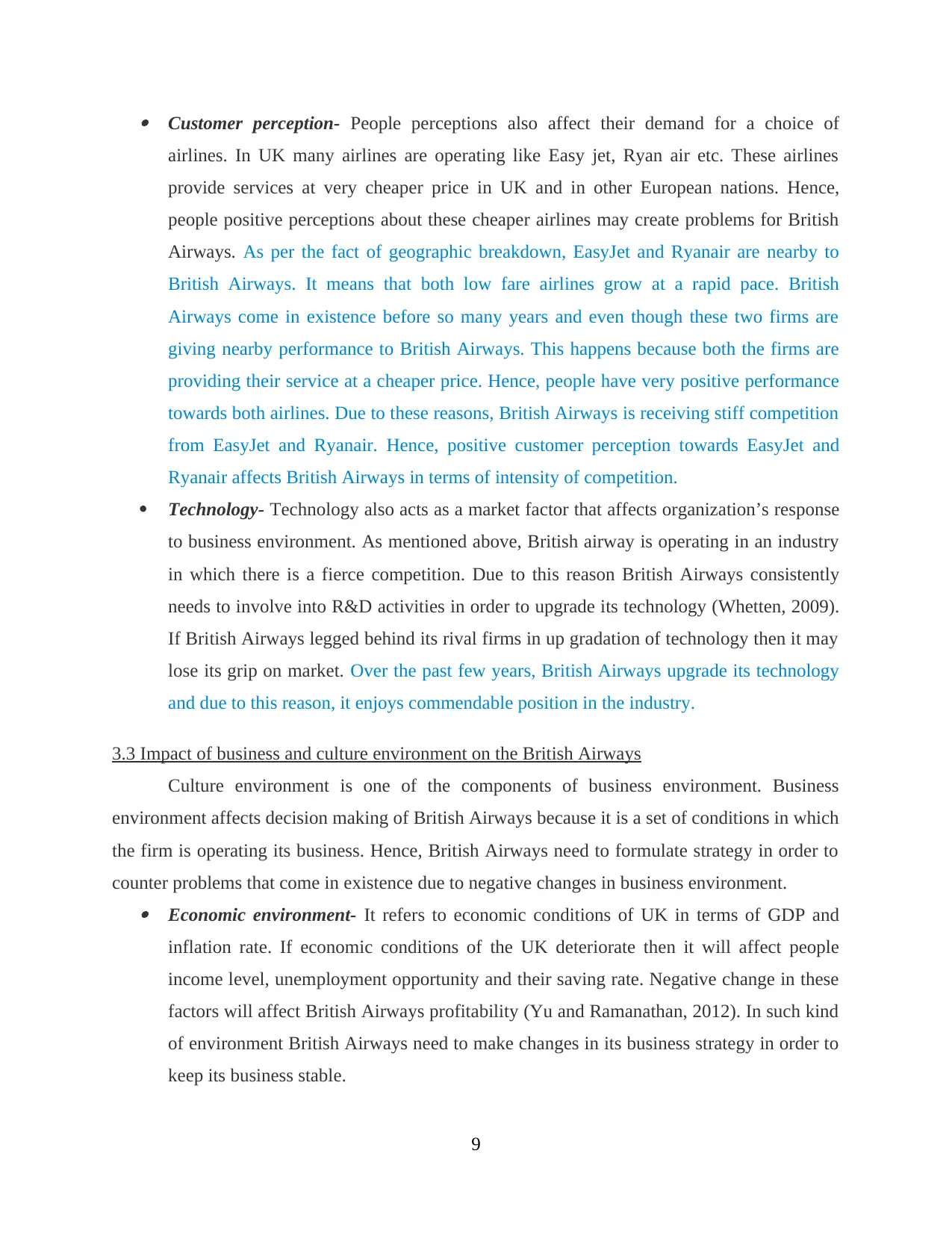
Customer perception- People perceptions also affect their demand for a choice of
airlines. In UK many airlines are operating like Easy jet, Ryan air etc. These airlines
provide services at very cheaper price in UK and in other European nations. Hence,
people positive perceptions about these cheaper airlines may create problems for British
Airways. As per the fact of geographic breakdown, EasyJet and Ryanair are nearby to
British Airways. It means that both low fare airlines grow at a rapid pace. British
Airways come in existence before so many years and even though these two firms are
giving nearby performance to British Airways. This happens because both the firms are
providing their service at a cheaper price. Hence, people have very positive performance
towards both airlines. Due to these reasons, British Airways is receiving stiff competition
from EasyJet and Ryanair. Hence, positive customer perception towards EasyJet and
Ryanair affects British Airways in terms of intensity of competition.
Technology- Technology also acts as a market factor that affects organization’s response
to business environment. As mentioned above, British airway is operating in an industry
in which there is a fierce competition. Due to this reason British Airways consistently
needs to involve into R&D activities in order to upgrade its technology (Whetten, 2009).
If British Airways legged behind its rival firms in up gradation of technology then it may
lose its grip on market. Over the past few years, British Airways upgrade its technology
and due to this reason, it enjoys commendable position in the industry.
3.3 Impact of business and culture environment on the British Airways
Culture environment is one of the components of business environment. Business
environment affects decision making of British Airways because it is a set of conditions in which
the firm is operating its business. Hence, British Airways need to formulate strategy in order to
counter problems that come in existence due to negative changes in business environment. Economic environment- It refers to economic conditions of UK in terms of GDP and
inflation rate. If economic conditions of the UK deteriorate then it will affect people
income level, unemployment opportunity and their saving rate. Negative change in these
factors will affect British Airways profitability (Yu and Ramanathan, 2012). In such kind
of environment British Airways need to make changes in its business strategy in order to
keep its business stable.
9
airlines. In UK many airlines are operating like Easy jet, Ryan air etc. These airlines
provide services at very cheaper price in UK and in other European nations. Hence,
people positive perceptions about these cheaper airlines may create problems for British
Airways. As per the fact of geographic breakdown, EasyJet and Ryanair are nearby to
British Airways. It means that both low fare airlines grow at a rapid pace. British
Airways come in existence before so many years and even though these two firms are
giving nearby performance to British Airways. This happens because both the firms are
providing their service at a cheaper price. Hence, people have very positive performance
towards both airlines. Due to these reasons, British Airways is receiving stiff competition
from EasyJet and Ryanair. Hence, positive customer perception towards EasyJet and
Ryanair affects British Airways in terms of intensity of competition.
Technology- Technology also acts as a market factor that affects organization’s response
to business environment. As mentioned above, British airway is operating in an industry
in which there is a fierce competition. Due to this reason British Airways consistently
needs to involve into R&D activities in order to upgrade its technology (Whetten, 2009).
If British Airways legged behind its rival firms in up gradation of technology then it may
lose its grip on market. Over the past few years, British Airways upgrade its technology
and due to this reason, it enjoys commendable position in the industry.
3.3 Impact of business and culture environment on the British Airways
Culture environment is one of the components of business environment. Business
environment affects decision making of British Airways because it is a set of conditions in which
the firm is operating its business. Hence, British Airways need to formulate strategy in order to
counter problems that come in existence due to negative changes in business environment. Economic environment- It refers to economic conditions of UK in terms of GDP and
inflation rate. If economic conditions of the UK deteriorate then it will affect people
income level, unemployment opportunity and their saving rate. Negative change in these
factors will affect British Airways profitability (Yu and Ramanathan, 2012). In such kind
of environment British Airways need to make changes in its business strategy in order to
keep its business stable.
9
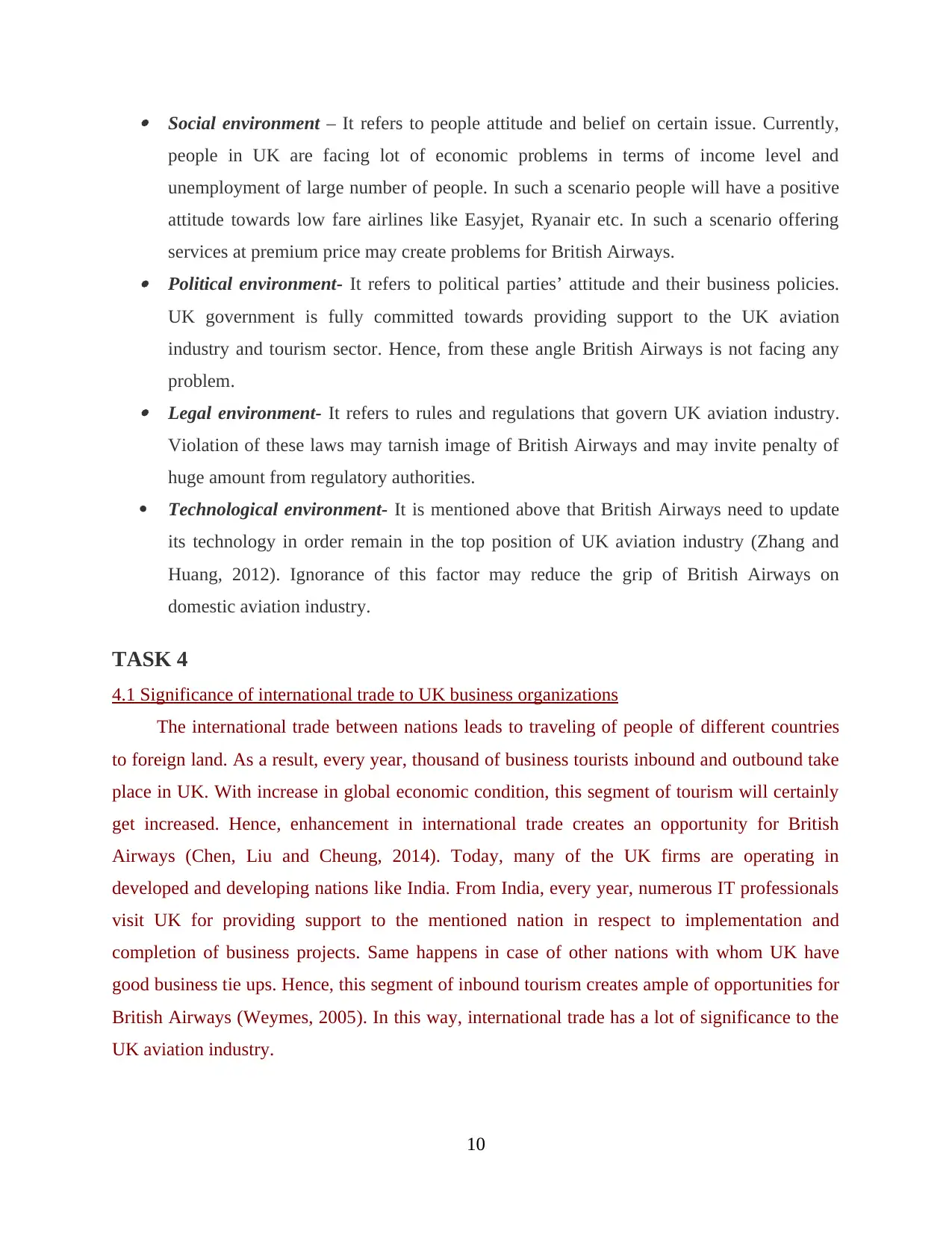
Social environment – It refers to people attitude and belief on certain issue. Currently,
people in UK are facing lot of economic problems in terms of income level and
unemployment of large number of people. In such a scenario people will have a positive
attitude towards low fare airlines like Easyjet, Ryanair etc. In such a scenario offering
services at premium price may create problems for British Airways. Political environment- It refers to political parties’ attitude and their business policies.
UK government is fully committed towards providing support to the UK aviation
industry and tourism sector. Hence, from these angle British Airways is not facing any
problem. Legal environment- It refers to rules and regulations that govern UK aviation industry.
Violation of these laws may tarnish image of British Airways and may invite penalty of
huge amount from regulatory authorities.
Technological environment- It is mentioned above that British Airways need to update
its technology in order remain in the top position of UK aviation industry (Zhang and
Huang, 2012). Ignorance of this factor may reduce the grip of British Airways on
domestic aviation industry.
TASK 4
4.1 Significance of international trade to UK business organizations
The international trade between nations leads to traveling of people of different countries
to foreign land. As a result, every year, thousand of business tourists inbound and outbound take
place in UK. With increase in global economic condition, this segment of tourism will certainly
get increased. Hence, enhancement in international trade creates an opportunity for British
Airways (Chen, Liu and Cheung, 2014). Today, many of the UK firms are operating in
developed and developing nations like India. From India, every year, numerous IT professionals
visit UK for providing support to the mentioned nation in respect to implementation and
completion of business projects. Same happens in case of other nations with whom UK have
good business tie ups. Hence, this segment of inbound tourism creates ample of opportunities for
British Airways (Weymes, 2005). In this way, international trade has a lot of significance to the
UK aviation industry.
10
people in UK are facing lot of economic problems in terms of income level and
unemployment of large number of people. In such a scenario people will have a positive
attitude towards low fare airlines like Easyjet, Ryanair etc. In such a scenario offering
services at premium price may create problems for British Airways. Political environment- It refers to political parties’ attitude and their business policies.
UK government is fully committed towards providing support to the UK aviation
industry and tourism sector. Hence, from these angle British Airways is not facing any
problem. Legal environment- It refers to rules and regulations that govern UK aviation industry.
Violation of these laws may tarnish image of British Airways and may invite penalty of
huge amount from regulatory authorities.
Technological environment- It is mentioned above that British Airways need to update
its technology in order remain in the top position of UK aviation industry (Zhang and
Huang, 2012). Ignorance of this factor may reduce the grip of British Airways on
domestic aviation industry.
TASK 4
4.1 Significance of international trade to UK business organizations
The international trade between nations leads to traveling of people of different countries
to foreign land. As a result, every year, thousand of business tourists inbound and outbound take
place in UK. With increase in global economic condition, this segment of tourism will certainly
get increased. Hence, enhancement in international trade creates an opportunity for British
Airways (Chen, Liu and Cheung, 2014). Today, many of the UK firms are operating in
developed and developing nations like India. From India, every year, numerous IT professionals
visit UK for providing support to the mentioned nation in respect to implementation and
completion of business projects. Same happens in case of other nations with whom UK have
good business tie ups. Hence, this segment of inbound tourism creates ample of opportunities for
British Airways (Weymes, 2005). In this way, international trade has a lot of significance to the
UK aviation industry.
10
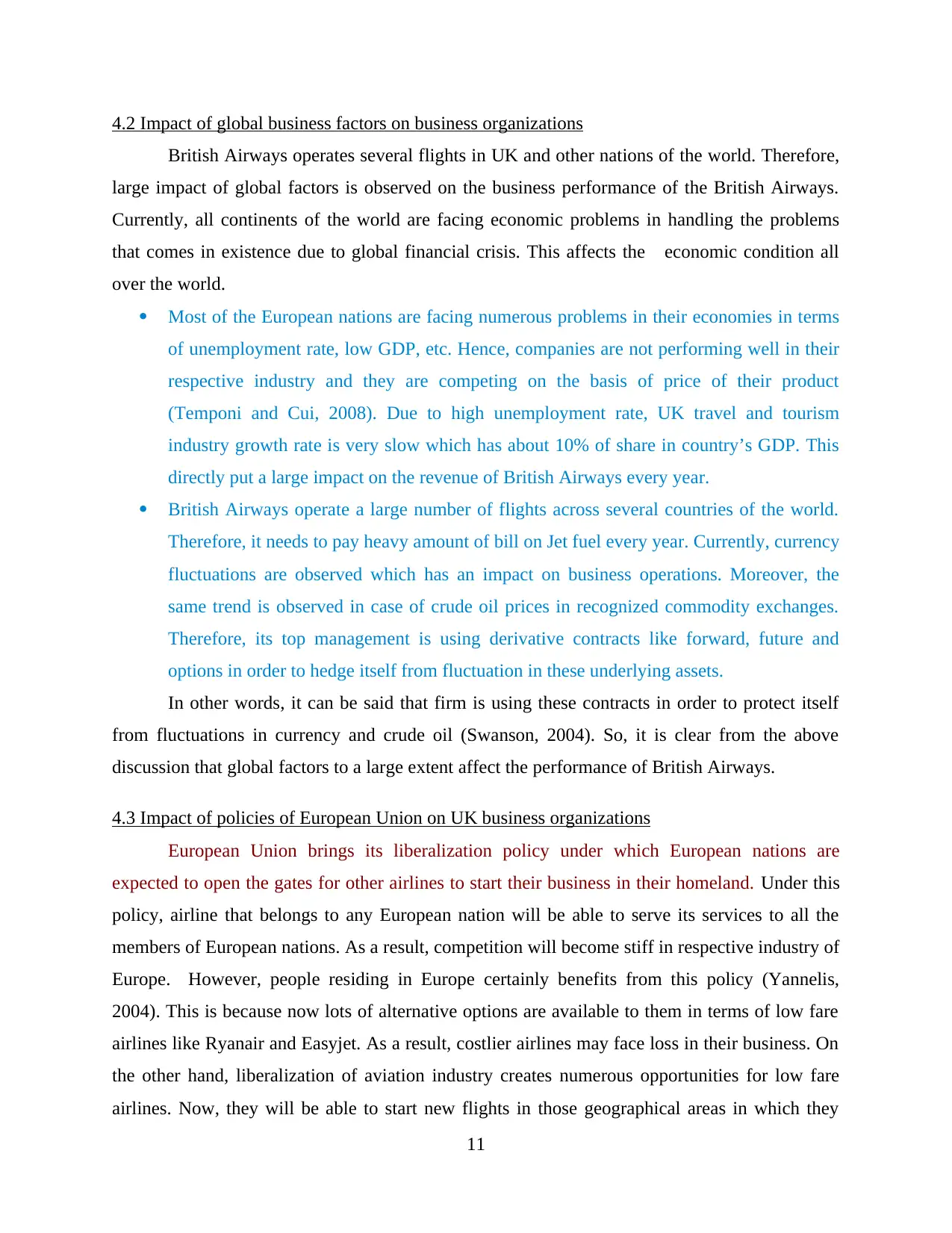
4.2 Impact of global business factors on business organizations
British Airways operates several flights in UK and other nations of the world. Therefore,
large impact of global factors is observed on the business performance of the British Airways.
Currently, all continents of the world are facing economic problems in handling the problems
that comes in existence due to global financial crisis. This affects the economic condition all
over the world.
Most of the European nations are facing numerous problems in their economies in terms
of unemployment rate, low GDP, etc. Hence, companies are not performing well in their
respective industry and they are competing on the basis of price of their product
(Temponi and Cui, 2008). Due to high unemployment rate, UK travel and tourism
industry growth rate is very slow which has about 10% of share in country’s GDP. This
directly put a large impact on the revenue of British Airways every year.
British Airways operate a large number of flights across several countries of the world.
Therefore, it needs to pay heavy amount of bill on Jet fuel every year. Currently, currency
fluctuations are observed which has an impact on business operations. Moreover, the
same trend is observed in case of crude oil prices in recognized commodity exchanges.
Therefore, its top management is using derivative contracts like forward, future and
options in order to hedge itself from fluctuation in these underlying assets.
In other words, it can be said that firm is using these contracts in order to protect itself
from fluctuations in currency and crude oil (Swanson, 2004). So, it is clear from the above
discussion that global factors to a large extent affect the performance of British Airways.
4.3 Impact of policies of European Union on UK business organizations
European Union brings its liberalization policy under which European nations are
expected to open the gates for other airlines to start their business in their homeland. Under this
policy, airline that belongs to any European nation will be able to serve its services to all the
members of European nations. As a result, competition will become stiff in respective industry of
Europe. However, people residing in Europe certainly benefits from this policy (Yannelis,
2004). This is because now lots of alternative options are available to them in terms of low fare
airlines like Ryanair and Easyjet. As a result, costlier airlines may face loss in their business. On
the other hand, liberalization of aviation industry creates numerous opportunities for low fare
airlines. Now, they will be able to start new flights in those geographical areas in which they
11
British Airways operates several flights in UK and other nations of the world. Therefore,
large impact of global factors is observed on the business performance of the British Airways.
Currently, all continents of the world are facing economic problems in handling the problems
that comes in existence due to global financial crisis. This affects the economic condition all
over the world.
Most of the European nations are facing numerous problems in their economies in terms
of unemployment rate, low GDP, etc. Hence, companies are not performing well in their
respective industry and they are competing on the basis of price of their product
(Temponi and Cui, 2008). Due to high unemployment rate, UK travel and tourism
industry growth rate is very slow which has about 10% of share in country’s GDP. This
directly put a large impact on the revenue of British Airways every year.
British Airways operate a large number of flights across several countries of the world.
Therefore, it needs to pay heavy amount of bill on Jet fuel every year. Currently, currency
fluctuations are observed which has an impact on business operations. Moreover, the
same trend is observed in case of crude oil prices in recognized commodity exchanges.
Therefore, its top management is using derivative contracts like forward, future and
options in order to hedge itself from fluctuation in these underlying assets.
In other words, it can be said that firm is using these contracts in order to protect itself
from fluctuations in currency and crude oil (Swanson, 2004). So, it is clear from the above
discussion that global factors to a large extent affect the performance of British Airways.
4.3 Impact of policies of European Union on UK business organizations
European Union brings its liberalization policy under which European nations are
expected to open the gates for other airlines to start their business in their homeland. Under this
policy, airline that belongs to any European nation will be able to serve its services to all the
members of European nations. As a result, competition will become stiff in respective industry of
Europe. However, people residing in Europe certainly benefits from this policy (Yannelis,
2004). This is because now lots of alternative options are available to them in terms of low fare
airlines like Ryanair and Easyjet. As a result, costlier airlines may face loss in their business. On
the other hand, liberalization of aviation industry creates numerous opportunities for low fare
airlines. Now, they will be able to start new flights in those geographical areas in which they
11
Paraphrase This Document
Need a fresh take? Get an instant paraphrase of this document with our AI Paraphraser
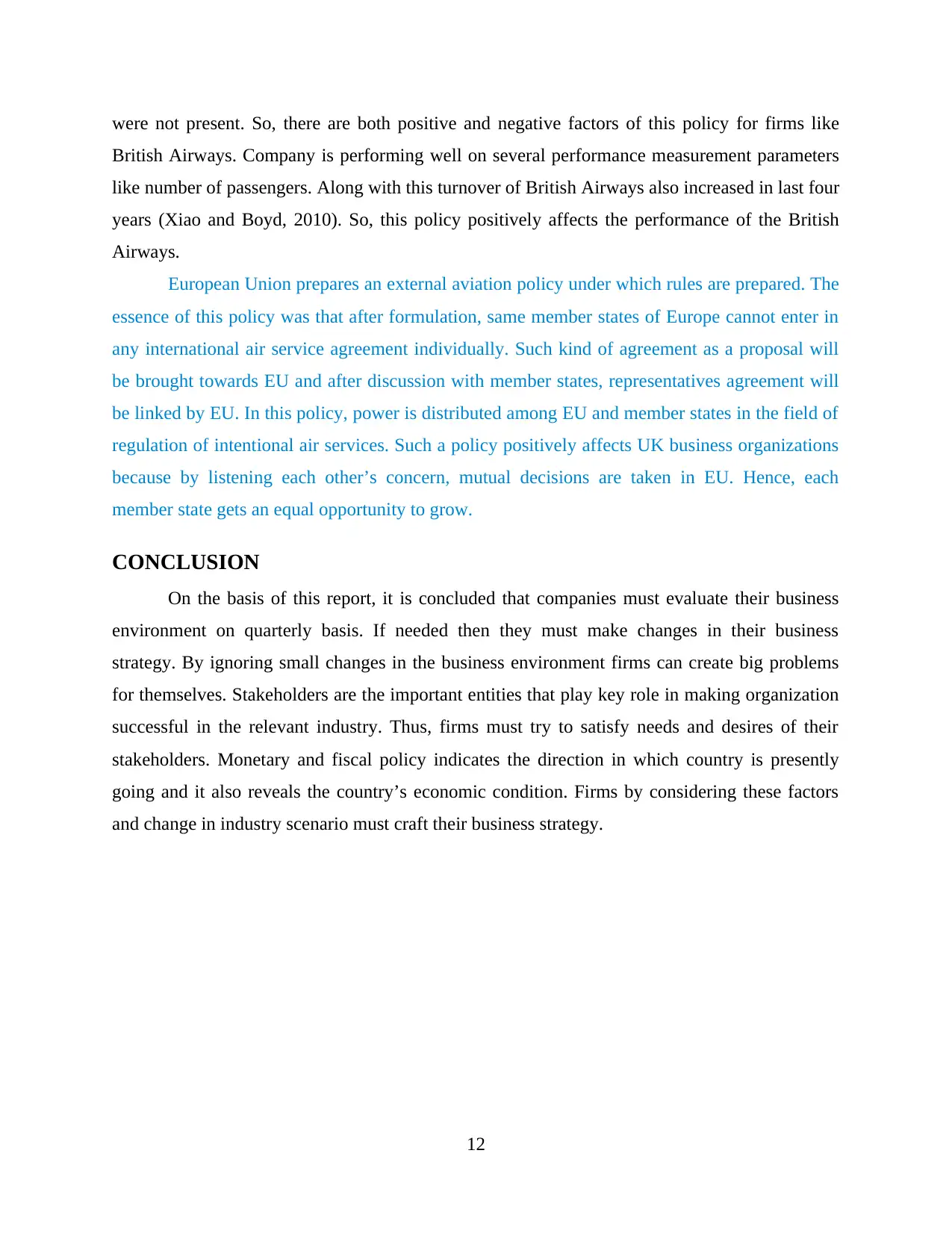
were not present. So, there are both positive and negative factors of this policy for firms like
British Airways. Company is performing well on several performance measurement parameters
like number of passengers. Along with this turnover of British Airways also increased in last four
years (Xiao and Boyd, 2010). So, this policy positively affects the performance of the British
Airways.
European Union prepares an external aviation policy under which rules are prepared. The
essence of this policy was that after formulation, same member states of Europe cannot enter in
any international air service agreement individually. Such kind of agreement as a proposal will
be brought towards EU and after discussion with member states, representatives agreement will
be linked by EU. In this policy, power is distributed among EU and member states in the field of
regulation of intentional air services. Such a policy positively affects UK business organizations
because by listening each other’s concern, mutual decisions are taken in EU. Hence, each
member state gets an equal opportunity to grow.
CONCLUSION
On the basis of this report, it is concluded that companies must evaluate their business
environment on quarterly basis. If needed then they must make changes in their business
strategy. By ignoring small changes in the business environment firms can create big problems
for themselves. Stakeholders are the important entities that play key role in making organization
successful in the relevant industry. Thus, firms must try to satisfy needs and desires of their
stakeholders. Monetary and fiscal policy indicates the direction in which country is presently
going and it also reveals the country’s economic condition. Firms by considering these factors
and change in industry scenario must craft their business strategy.
12
British Airways. Company is performing well on several performance measurement parameters
like number of passengers. Along with this turnover of British Airways also increased in last four
years (Xiao and Boyd, 2010). So, this policy positively affects the performance of the British
Airways.
European Union prepares an external aviation policy under which rules are prepared. The
essence of this policy was that after formulation, same member states of Europe cannot enter in
any international air service agreement individually. Such kind of agreement as a proposal will
be brought towards EU and after discussion with member states, representatives agreement will
be linked by EU. In this policy, power is distributed among EU and member states in the field of
regulation of intentional air services. Such a policy positively affects UK business organizations
because by listening each other’s concern, mutual decisions are taken in EU. Hence, each
member state gets an equal opportunity to grow.
CONCLUSION
On the basis of this report, it is concluded that companies must evaluate their business
environment on quarterly basis. If needed then they must make changes in their business
strategy. By ignoring small changes in the business environment firms can create big problems
for themselves. Stakeholders are the important entities that play key role in making organization
successful in the relevant industry. Thus, firms must try to satisfy needs and desires of their
stakeholders. Monetary and fiscal policy indicates the direction in which country is presently
going and it also reveals the country’s economic condition. Firms by considering these factors
and change in industry scenario must craft their business strategy.
12
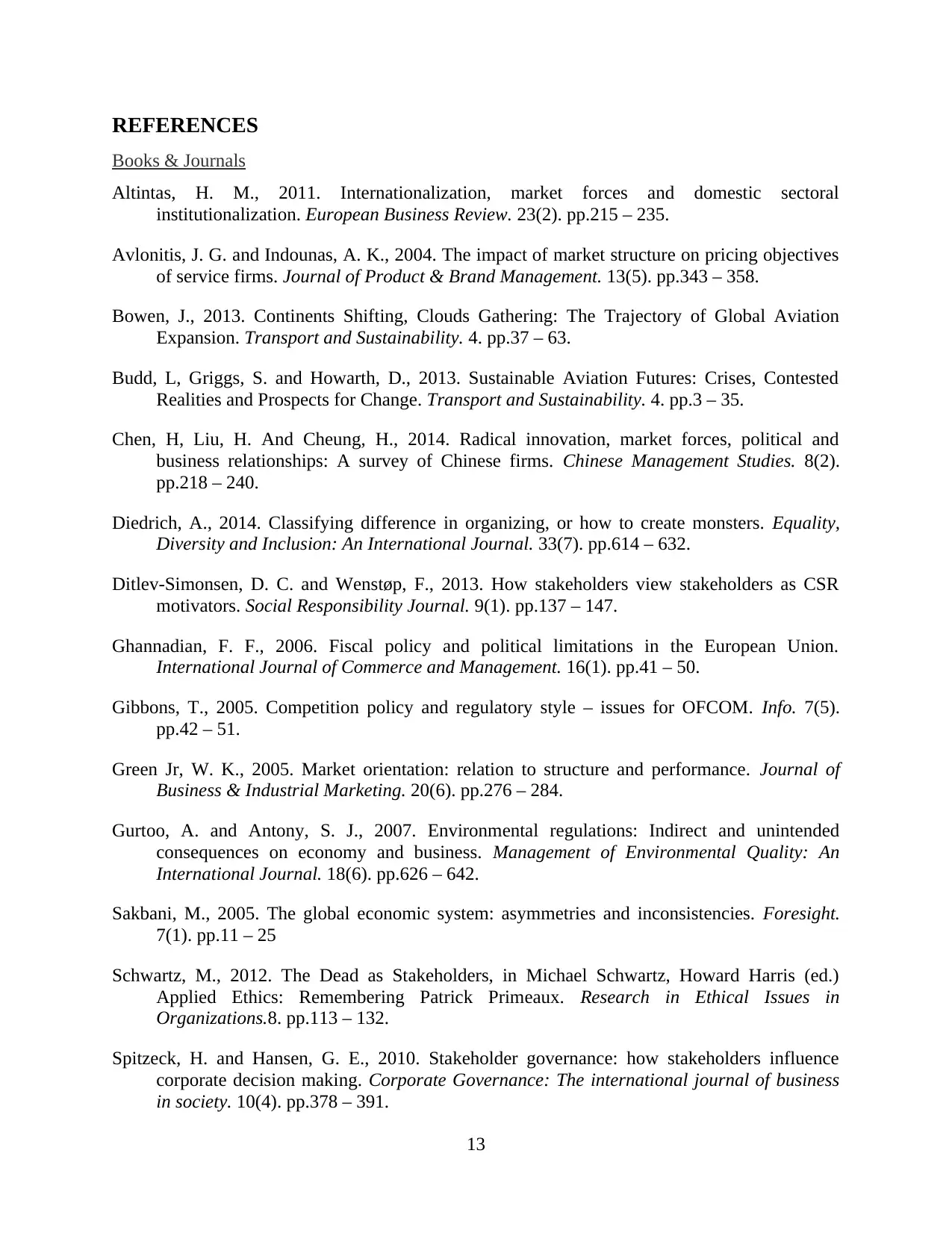
REFERENCES
Books & Journals
Altintas, H. M., 2011. Internationalization, market forces and domestic sectoral
institutionalization. European Business Review. 23(2). pp.215 – 235.
Avlonitis, J. G. and Indounas, A. K., 2004. The impact of market structure on pricing objectives
of service firms. Journal of Product & Brand Management. 13(5). pp.343 – 358.
Bowen, J., 2013. Continents Shifting, Clouds Gathering: The Trajectory of Global Aviation
Expansion. Transport and Sustainability. 4. pp.37 – 63.
Budd, L, Griggs, S. and Howarth, D., 2013. Sustainable Aviation Futures: Crises, Contested
Realities and Prospects for Change. Transport and Sustainability. 4. pp.3 – 35.
Chen, H, Liu, H. And Cheung, H., 2014. Radical innovation, market forces, political and
business relationships: A survey of Chinese firms. Chinese Management Studies. 8(2).
pp.218 – 240.
Diedrich, A., 2014. Classifying difference in organizing, or how to create monsters. Equality,
Diversity and Inclusion: An International Journal. 33(7). pp.614 – 632.
Ditlev-Simonsen, D. C. and Wenstøp, F., 2013. How stakeholders view stakeholders as CSR
motivators. Social Responsibility Journal. 9(1). pp.137 – 147.
Ghannadian, F. F., 2006. Fiscal policy and political limitations in the European Union.
International Journal of Commerce and Management. 16(1). pp.41 – 50.
Gibbons, T., 2005. Competition policy and regulatory style – issues for OFCOM. Info. 7(5).
pp.42 – 51.
Green Jr, W. K., 2005. Market orientation: relation to structure and performance. Journal of
Business & Industrial Marketing. 20(6). pp.276 – 284.
Gurtoo, A. and Antony, S. J., 2007. Environmental regulations: Indirect and unintended
consequences on economy and business. Management of Environmental Quality: An
International Journal. 18(6). pp.626 – 642.
Sakbani, M., 2005. The global economic system: asymmetries and inconsistencies. Foresight.
7(1). pp.11 – 25
Schwartz, M., 2012. The Dead as Stakeholders, in Michael Schwartz, Howard Harris (ed.)
Applied Ethics: Remembering Patrick Primeaux. Research in Ethical Issues in
Organizations.8. pp.113 – 132.
Spitzeck, H. and Hansen, G. E., 2010. Stakeholder governance: how stakeholders influence
corporate decision making. Corporate Governance: The international journal of business
in society. 10(4). pp.378 – 391.
13
Books & Journals
Altintas, H. M., 2011. Internationalization, market forces and domestic sectoral
institutionalization. European Business Review. 23(2). pp.215 – 235.
Avlonitis, J. G. and Indounas, A. K., 2004. The impact of market structure on pricing objectives
of service firms. Journal of Product & Brand Management. 13(5). pp.343 – 358.
Bowen, J., 2013. Continents Shifting, Clouds Gathering: The Trajectory of Global Aviation
Expansion. Transport and Sustainability. 4. pp.37 – 63.
Budd, L, Griggs, S. and Howarth, D., 2013. Sustainable Aviation Futures: Crises, Contested
Realities and Prospects for Change. Transport and Sustainability. 4. pp.3 – 35.
Chen, H, Liu, H. And Cheung, H., 2014. Radical innovation, market forces, political and
business relationships: A survey of Chinese firms. Chinese Management Studies. 8(2).
pp.218 – 240.
Diedrich, A., 2014. Classifying difference in organizing, or how to create monsters. Equality,
Diversity and Inclusion: An International Journal. 33(7). pp.614 – 632.
Ditlev-Simonsen, D. C. and Wenstøp, F., 2013. How stakeholders view stakeholders as CSR
motivators. Social Responsibility Journal. 9(1). pp.137 – 147.
Ghannadian, F. F., 2006. Fiscal policy and political limitations in the European Union.
International Journal of Commerce and Management. 16(1). pp.41 – 50.
Gibbons, T., 2005. Competition policy and regulatory style – issues for OFCOM. Info. 7(5).
pp.42 – 51.
Green Jr, W. K., 2005. Market orientation: relation to structure and performance. Journal of
Business & Industrial Marketing. 20(6). pp.276 – 284.
Gurtoo, A. and Antony, S. J., 2007. Environmental regulations: Indirect and unintended
consequences on economy and business. Management of Environmental Quality: An
International Journal. 18(6). pp.626 – 642.
Sakbani, M., 2005. The global economic system: asymmetries and inconsistencies. Foresight.
7(1). pp.11 – 25
Schwartz, M., 2012. The Dead as Stakeholders, in Michael Schwartz, Howard Harris (ed.)
Applied Ethics: Remembering Patrick Primeaux. Research in Ethical Issues in
Organizations.8. pp.113 – 132.
Spitzeck, H. and Hansen, G. E., 2010. Stakeholder governance: how stakeholders influence
corporate decision making. Corporate Governance: The international journal of business
in society. 10(4). pp.378 – 391.
13
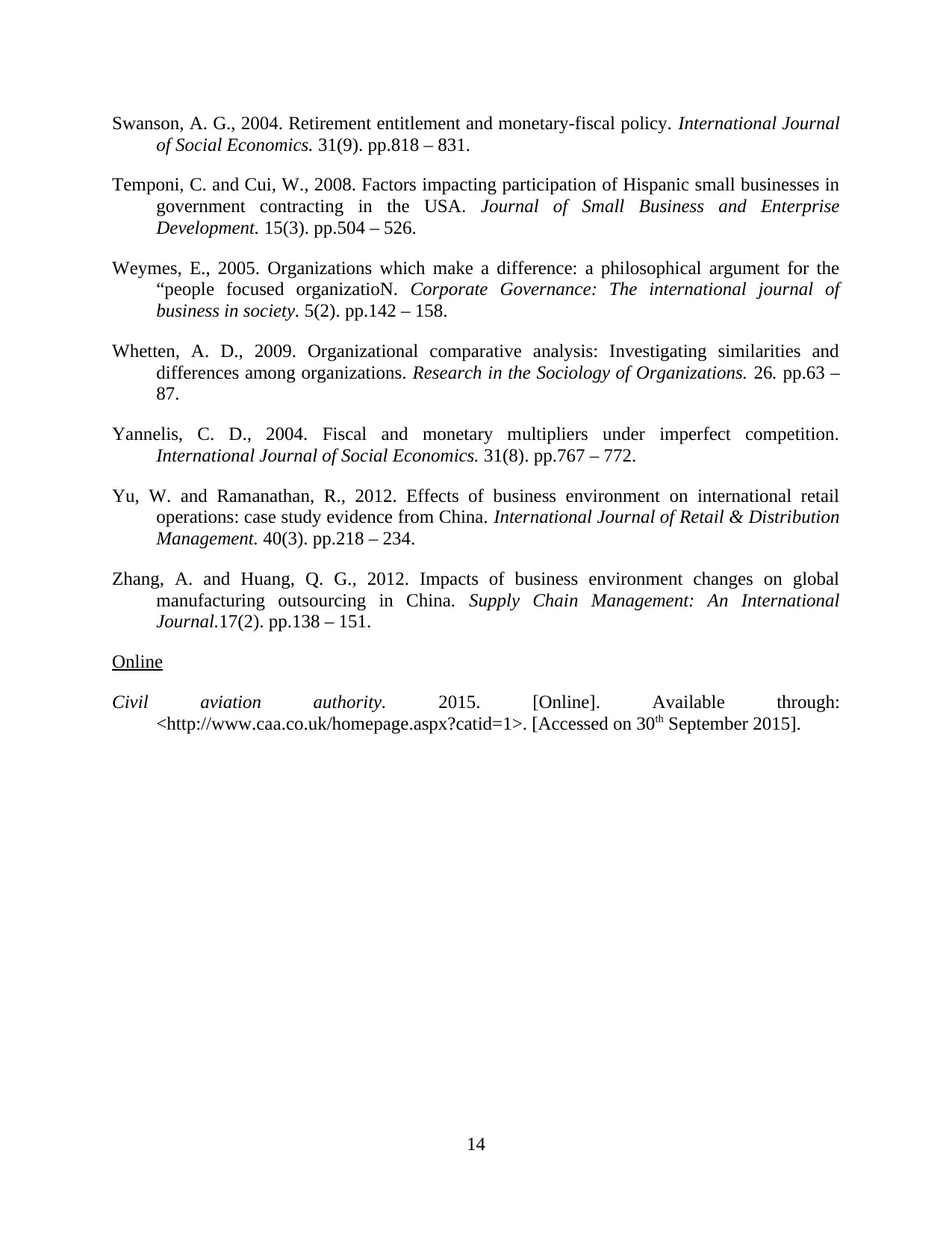
Swanson, A. G., 2004. Retirement entitlement and monetary-fiscal policy. International Journal
of Social Economics. 31(9). pp.818 – 831.
Temponi, C. and Cui, W., 2008. Factors impacting participation of Hispanic small businesses in
government contracting in the USA. Journal of Small Business and Enterprise
Development. 15(3). pp.504 – 526.
Weymes, E., 2005. Organizations which make a difference: a philosophical argument for the
“people focused organizatioN. Corporate Governance: The international journal of
business in society. 5(2). pp.142 – 158.
Whetten, A. D., 2009. Organizational comparative analysis: Investigating similarities and
differences among organizations. Research in the Sociology of Organizations. 26. pp.63 –
87.
Yannelis, C. D., 2004. Fiscal and monetary multipliers under imperfect competition.
International Journal of Social Economics. 31(8). pp.767 – 772.
Yu, W. and Ramanathan, R., 2012. Effects of business environment on international retail
operations: case study evidence from China. International Journal of Retail & Distribution
Management. 40(3). pp.218 – 234.
Zhang, A. and Huang, Q. G., 2012. Impacts of business environment changes on global
manufacturing outsourcing in China. Supply Chain Management: An International
Journal.17(2). pp.138 – 151.
Online
Civil aviation authority. 2015. [Online]. Available through:
<http://www.caa.co.uk/homepage.aspx?catid=1>. [Accessed on 30th September 2015].
14
of Social Economics. 31(9). pp.818 – 831.
Temponi, C. and Cui, W., 2008. Factors impacting participation of Hispanic small businesses in
government contracting in the USA. Journal of Small Business and Enterprise
Development. 15(3). pp.504 – 526.
Weymes, E., 2005. Organizations which make a difference: a philosophical argument for the
“people focused organizatioN. Corporate Governance: The international journal of
business in society. 5(2). pp.142 – 158.
Whetten, A. D., 2009. Organizational comparative analysis: Investigating similarities and
differences among organizations. Research in the Sociology of Organizations. 26. pp.63 –
87.
Yannelis, C. D., 2004. Fiscal and monetary multipliers under imperfect competition.
International Journal of Social Economics. 31(8). pp.767 – 772.
Yu, W. and Ramanathan, R., 2012. Effects of business environment on international retail
operations: case study evidence from China. International Journal of Retail & Distribution
Management. 40(3). pp.218 – 234.
Zhang, A. and Huang, Q. G., 2012. Impacts of business environment changes on global
manufacturing outsourcing in China. Supply Chain Management: An International
Journal.17(2). pp.138 – 151.
Online
Civil aviation authority. 2015. [Online]. Available through:
<http://www.caa.co.uk/homepage.aspx?catid=1>. [Accessed on 30th September 2015].
14
1 out of 16
Related Documents
Your All-in-One AI-Powered Toolkit for Academic Success.
+13062052269
info@desklib.com
Available 24*7 on WhatsApp / Email
![[object Object]](/_next/static/media/star-bottom.7253800d.svg)
Unlock your academic potential
© 2024 | Zucol Services PVT LTD | All rights reserved.





